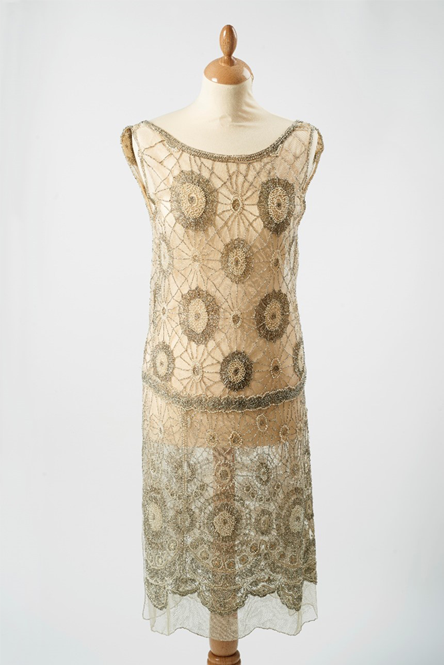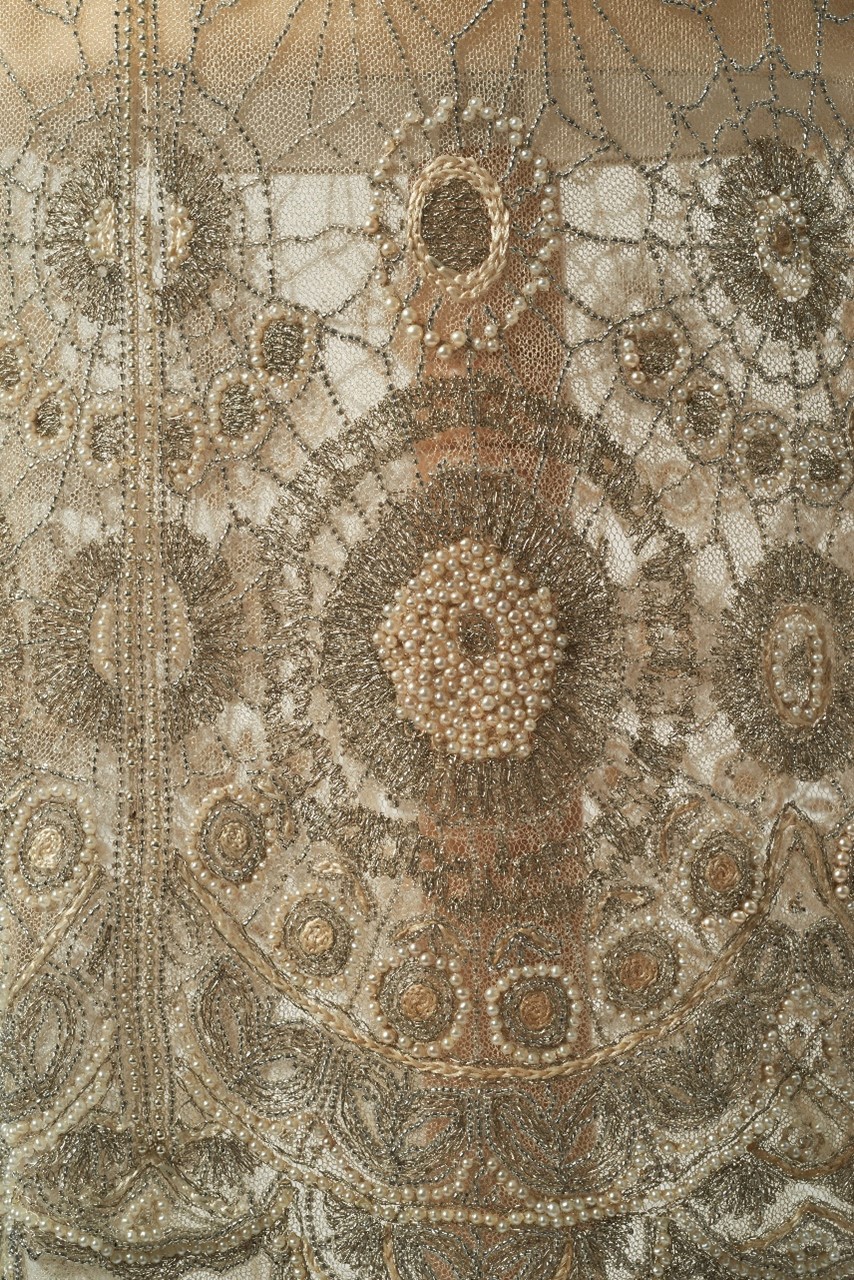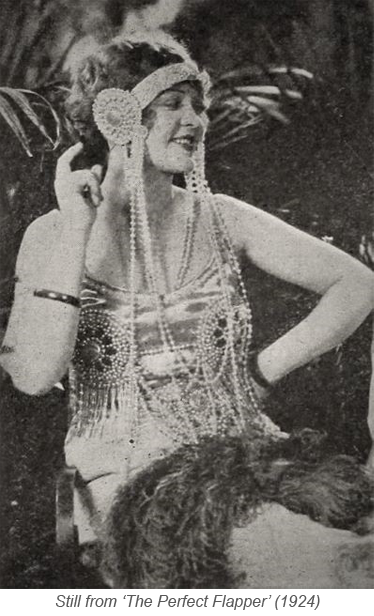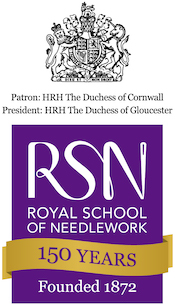Step into the dazzling world of the 1920s with RSN Collection volunteer Belle Riou as she analyses a glass beaded flapper dress in the Royal School of Needlework’s Collection. Discover how this iconic piece reflects the vibrant spirit of the Jazz Age, where innovation, societal shifts, and the rise of electric lighting converged to redefine fashion and nightlife.
Belle Riou is a volunteer at the Royal School of Needlework, where she assists in the digitisation and cataloguing of the collection.
As a fashion historian, the one piece in the collection that stood out to me amidst the amazingly diverse range of garments and pieces is a fabulously archetypal 1920s flapper dress.
Adorned in glass beads, sequins, and gold thread embroidery, this dress highlights an eye-catching geometric spiderweb design. I am writing about this piece not just because it is beautiful and deserves to be spotlighted, but also because during my research into the history of 1920s embroidery for the cataloguing of this object I uncovered some wonderful information highlighting the popularity of glass beaded embroidery during this period.
The information I came across provides us with a fascinating glimpse into the tastes, context, and socio-political background of one of history’s most iconic eras.

Emerging from the aftermath of the First World War, the 1920s has etched its name in history as an era synonymous with innovation, cultural dynamism, and, of course, fashion. This was a reactive time, in which a culture of hedonism took root that gave rise to an extravagant and thrilling decade, characterised by glamorous fashion, vibrant music, and a feverish passion for dancing and frivolity.
Together, this time of consumerism and excess became known as the Jazz Age. The lavish designs that surfaced during this period, evident in evening gowns, party dresses, and accessories crafted from shining fabrics like silk and taffeta and adorned with intricate embroidery, beads, feathers, tassels, and sashes, epitomised the growing enthusiasm for this new exuberant lifestyle.
This cultural shift coincided with growing liberation and the idea of the ‘New Woman’, and the opulent designs that surfaced embodied this engagement with shifting gender norms and freedoms. Dresses became sleeveless and ended above the knee, silhouettes changed to have dropped waists and more boyish shapes, and embellishments became both more detailed and more exotic, with stylised embroidery, sequins, and metallic threads creating some of the most glamorous looks of the 20th century. Among these, the flapper dress has become the era’s most memorable style.
Though flapper dresses are now synonymous with the 1920s, it should be noted that these dresses were not worn by everyone – far from it. Nor were they part of everyday attire. They garnered immense popularity among a select few and were eventually established as the aspirational modern ideal. Many of these dresses were intricately adorned with sequins, feathers, tassels, and gold thread, but it was glass beading that emerged as the most luxurious and popular decoration.

Whilst beaded embroidery had been popular in past time periods, it was against the backdrop of the exuberant 1920s that its popularity surged, with glass beads becoming so fashionable they were often even designed to replicate precious stones and pearls. The sparkling spiderweb glass beaded dress held at the Royal School of Needlework embodies the spirit of the era with mesmerising, detailed beadwork and wonderful craftsmanship.
Embroidery and the use of glass beads in clothing and jewellery became a trademark of Coco Chanel – who is considered to have created, or at least popularised, the flapper style – during this period. Many high end designers incorporated glass beads from Europe, especially Czech glass beads, into their designs. Skirts were designed to move and sway with a woman’s movements, and glass beads, metal threads, and sequins were used to complement the unique design of the flapper dress. These heavy materials gave flapper dresses their weight, movement, and sparkle. The glass beading would have shimmered under the artificial lights inside clubs and bars, remaining steadfast even into the early 1930s before more simplistic, bias-cut styles rose to popularity.

The use of artificial, electric lighting is also pertinent here. On the surface, there seems to be little connection between the development of fashion and culture and the rise of electricity. However, they actually complement each other nicely. During the late 19th and early 20th centuries, the rise of electricity revolutionised many aspects of daily life. Electric lighting provided brighter and more consistent illumination compared to gas or oil lamps. This completely changed how some individuals spent their time, allowing many to extend their activities further into the evening hours. This shift had profound effects on social behaviour, leisure activities, and fashion, redefining what many knew as night life, with clubs, bars and speakeasies booming in number and popularity. And it was on these dance floors that opulent flapper gowns covered in glittering glass beads would have shined under bright electric lights.
Though the electric light phenomenon was established in the late 1800s, it was the 1920s that witnessed a surge in the use of electricity, and the popularity of glass bead embroidery grew,
in part, for this very same reason. Czech glass beads, mentioned above, were able to imitate the sparkle of precious gems and were made in colours that matched them. Particular favourites were ruby, carnelian, and turquoise. These beads were accompanied by Japanese pearls, cultivated using new methods, and Bakelite beads that imitated more pricey materials such as ivory, amber, and jet. Designers and artisans incorporated glass beads and these other decorative materials to highlight the shimmering effect created by these beads under electric lights, adding an extra dimension of glamour and sophistication to attire and making them highly desirable among the fashionable elite and even those who could only afford cheaper alternatives. As such, flapper dresses, with their loose, straight silhouettes, flowing skirts, and intricate embellishments featured elaborate beadwork that captured the essence of the Jazz Age simply with their movement.
Combined with the new wave of lively music and shifting societal expectations, the rise in electric lighting can be closely tied with the era’s iconic flapper style, embracing exuberance, excess, and innovation. Studying something as seemingly simple as glass bead embroidery opens a window into the vibrant cultural landscape of the Jazz Age, illustrating in glittering colour a society emerging from the shadows of war, embracing newfound freedoms, and redefining notions of femininity and self-expression.
Bibliography:
Catherine Gourley, Flappers and the New American Woman: Perceptions of Women from 1918 Through the 1920s (Minneapolis: Twenty-First Century Books, 2007).
Judith Mackrell, Flappers: Six Women of a Dangerous Generation (London: Pan, 2014).
Frederik Nebeker, Dawn of the Electronic Age: Electrical Technologies in the Shaping of the Modern World, 1914 to 1945 (Hoboken: Wiley, 2009).
Charles A. Riley, Free as Gods: How the Jazz Age Reinvented Modernism (Lebanon, New Hampshire: ForeEdge, 2017).
Linda Simon, Lost Girls: The Invention of the Flapper (London: Reaktion Books, 2017).
